Russian President Vladimir Putin is set to use his secret new technology in huge military exercises to simulate nuclear explosions as the war in Ukraine continues.
Researchers at the Military Logistics Academy in St. Petersburg have patented a new simulator for ground-based nuclear explosions. The use of this simulator will improve the training quality of ground force units for combat operations under conditions that simulate the usage of nuclear weapons, the patent description reads, according to a TASS report.
“The purpose of the model is to provide a clear simulation of the visual characteristics — the impact effect, lightning flash and mushroom cloud of a nuclear explosion on the ground,” according to the patent. The invention will be used in exercises and practical training with military units for combat operations, as well as radiation, chemical, and biological ground reconnaissance units.
According to the scientists, the IU-59 nuclear explosion simulator was previously used for this purpose, but it is now obsolete and is no longer produced by industrial enterprises. In addition, the samples available in the warehouses of military units have exhausted their technical life and are categorically prohibited from use. Also in the description is the IAB-500 simulated aerial bomb, designed to simulate the combat use of the RN-24 special munition, an aerial bomb with a nuclear warhead.
“The disadvantage of the IAB-500 is that this model was developed only for aviation; for this reason, conducting practical exercises for training military units in radiological, chemical and biological reconnaissance was not economically feasible, as it required costs that often exceeded the result obtained. In addition, the IAB-500 was withdrawn from service in 1984 and is no longer produced by industrial companies,” the document states.





